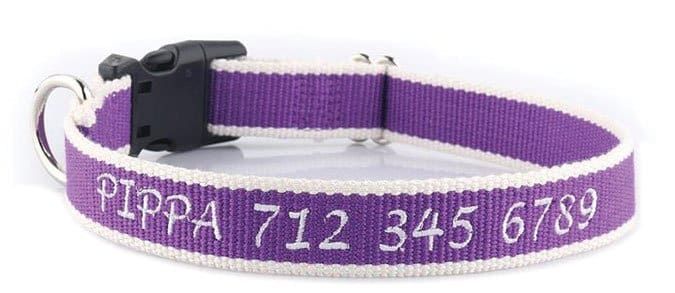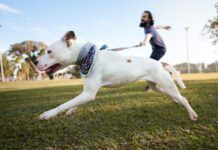What type of collar should your dog wear? It depends on your dog, your personal taste, and your training goals, philosophies, and needs. But from our force-free perspective, there are some types of collars we wholeheartedly endorse, some we support with caution, and some that we regard as unnecessary and risky.
The Most Dangerous Dog Collars
Let’s get these out of the way first. We recommend that you never use collars that are designed to work through the application of pain, discomfort, or aversive sensations, including:
- Choke chains
- Prong collars
- Shock collars (training or no-bark)
- Citronella spray collars
- Any other collar designed to force compliance.
There are numerous current marketing attempts to make these collars more palatable to the public, including attractive, colorful cloth covers for prong collars, rubber tips for the prongs, and euphemisms for shock that range for “stim” and “tickle” to “e-collar” and “e-touch.”
In fact, shock-collar sales reps are quite skilled at convincing their clients that the application of an electrical stimulation doesn’t really hurt, while old-fashioned trainers are equally skilled at convincing these clients that the use of force is necessary to train a dog properly. Don’t be fooled. Shock hurts. And recent studies overwhelmingly support the position that, while old-fashioned, force-based training methods can work, they also come with a significant risk of causing injury (choke chains are known to damage canine tracheas) and creating behavioral problems, especially fear and aggression. These tools and the old-fashioned ways they are typically used often result in shutting dogs down – not something we want to see in our dogs. In contrast, we value confident dogs who are willing to offer behavior, something that many dogs who have been trained with behavior-suppressing methods don’t often do.

The bottom line with all these collars is that they work because they hurt or intimidate your dog – not a good training philosophy.
Dog Collars for Special Situations: Not for Every Dog
Then there are the products we would support the use of, in just the right situation, and in the right hands.
Head Halters or Head Collars
While there are many different varieties and brands of head collars, they all function by moving the point of attachment from the dog’s neck to the dog’s head. This gives the handler greater physical control of the dog’s head – and where the head goes, the body follows. A dog who is accustomed to pulling hard on leash with a conventional collar will find that he cannot easily pull while wearing a head collar.
Our first reservation about these collars is that many dogs (perhaps even the majority) find them mildly to extremely aversive. While they look kinder to us than prong and shock collars, if they are aversive to the dog, they are not a force-free training tool.
That said, if the handler takes enough time to properly condition a dog to a head collar, some dogs learn to accept the collars and seem reasonably comfortable with them. Other dogs dislike head halters no matter how much conditioning is done. You can see dogs who have worn these for years but still try to rub them off every chance they get.
Another concern about head halters is that they tend to shut down behavior, so you may think you’re seeing a behavior change when, in fact, the dog is so stressed by the head collar that he stops offering unwanted behaviors. In other words, the discomfort of the collar just suppresses the behaviors you don’t like; he hasn’t learned to exhibit the behaviors you enjoy more in order to earn rewards from you. If you try this collar with your dog, be prepared to discover that your dog is one of the many for whom it is not appropriate because it is aversive.
Our final reservation has to do with the fact that this tool can be used to severely injure a dog if used improperly. A handler must never yank or pull hard on the leash, or allow the dog to hit the end of the leash with force when it’s attached to a head halter. Doing so can badly injure the dog’s neck or even paralyze him. It’s critical that handlers are taught how to use this tool properly: gently and with great awareness.
Slip Lead / Show Lead / Loop Lead
These are collars of convenience, often used by animal shelters and rescues, but also often in conformation showing. A slip lead is actually a leash/collar combination, made of a length of nylon or leather with a handle at one end and a ring at the other. The leash is pulled through the ring to form a slip collar at one end. This means that, like a choke chain, the collar part can tighten without limit, so there is potential for choking the dog.
Because dogs in shelters often must be moved quickly without time for collar fitting, this can be an acceptable brief use. (A product with all the convenience and less risk than the slip lead is the martingale variety of the show lead, which can tighten only to a specified point; martingale collars are covered below). If shelter dogs are to be taken for “real” walks, more appropriate equipment, such as flat collars or front-clip harnesses, should be used.
Show dogs are presumably trained to walk with their handlers, so while those collars sometimes look tight around a dog’s neck, it’s unlikely the dog is pulling on them the way an untrained dog might on a choke chain.
The slip leads used in shelters and rescues are generally workmanlike and made of sturdy nylon. In contrast, the ones used in shows are usually made with lightweight leather, nylon, or a thin chain. However, the function is the same, and they all have some potential to choke and cause trachea damage if a dog pulls hard and persistently, or if the handler jerks on them, in a way that they were not intended to be used.
Whole Dog Journal‘s Favorite Dog Collars
Without getting name-brand specific, here are the types of collars we do like – and why.
Flat Collar
Your basic flat collar offers you many choices: leather, nylon, cloth; in solid colors, patterns, floral, embroidered, holiday-themed, bejeweled, reflective, glowing, padded; and with buckle or snap fasteners. You can even order collars embroidered with your phone number, in case your dog goes astray, and others with bow ties for “formal” occasions. A properly fitted flat collar allows you to slip two fingers under the collar (perpendicular to the dog’s neck).
The flat collar is great for everyday use, such as holding ID tags and perhaps for general walking and training purposes. If your dog is a dedicated puller, however, a front-clip control harness is a better choice for walks and training, until she learns how reinforcing it is to stay close to you.
See the “2018 Best Dog Harnesses Review” for Whole Dog Journal‘s harness recommendations if you think your dog is ready for one.
Martingale Collar
Also called a “limited slip” collar, the martingale has a loop that allows the collar to tighten somewhat, but isn’t intended to choke or give “corrections.” The primary purpose of this collar is to prevent your dog from backing out of the collar, as some dogs learn to do with a flat collar. The loop allows the collar to hang comfortably until the dog pulls back, then the loop tightens just enough to keep it from sliding over the dog’s head.
Note: Because the loop can get caught on objects, this collar should only be on the dog under supervision, not left on all the time.
Martingale collars are also commonly called “Greyhound collars,” as they are frequently used with this breed, whose narrow heads make it easy for them to slip out of flat collars. However, a martingale collar can also more securely hold thick-necked dogs, such as Bulldogs, whose necks are as wide as their heads are large.
The martingale collar should be fitted so that when the dog pulls it tightens just enough to prevent the dog from backing out of it, but not so tight that it chokes or restricts breathing in any way.
Safety or Breakaway Dog Collars

This collar has a mechanism that releases under pressure, to prevent accidental hanging if it gets snagged on something, or choking when two dogs are wrestling and playing collar-grab. The double-ring feature allows you to attach a leash without triggering the breakaway function even if your dog pulls hard. This can be a very useful collar, especially if your dog plays with other dogs who like to grab collars.
The downside is, if you have to grasp the collar suddenly in an emergency, it will come open and pull free from your dog’s neck. Therefore, while it can be useful, it does have limited application, and should not be used if you are in an open space where you may need to grab the collar.
Dog Collars for Unique Situations
Dogs who have extremely thin coats may benefit from wearing a fleece-lined collar, which won’t rub their hair off like many other materials can. Our favorite fleece-lined collars come from Planet Dog. Note that the fleece collars don’t come in a size suitable for tiny dogs, however.
Big, strong dogs who are allowed to pull strongly on leash, such as some dogs who work in law enforcement, tracking, and personal protection, are generally fitted with extra-wide collars, which disperse the pressure over a wider area on the wearer’s neck to prevent injury. Buckles on these collars are generally made with one or two metal tongues, rather than plastic or metal side-release buckles, for greatest strength. Check out the offerings from Blocky Dogs.
It can also be difficult to find collars that fit tiny dogs well – and often, when you do find a really small collar, the ring is so tiny that it’s hard to attach a leash or ID tag. We like this source for stylish small-dog collars.
Nix the jingling! We like collars that can be ordered with your contact information stitched right into the fabric, like these washable, durable bamboo collars from snazzyfido.com.
Avoid These Common Dog Collar Dangers
Even the best collars have the potential to cause harm to your dog if not used wisely. Here are some tips and cautions for proper, safe collar use:
1. Don’t Leave Collars on Unattended Dogs
Any collar left on an unattended dog has the potential to catch on something and hang the dog. In fact, some agility and barn hunt venues don’t allow dogs to wear collars while they are running the course, for fear that the collar could get caught on something. It is also possible for a dog to get her lower jaw caught in the collar.
While hanging potential is greatest with a choke collar (yes, this sadly happened to a St. Bernard of mine when I was young and too dumb to know better), it can also happen with regular flat collars. I do leave flat collars on my dogs – the tradeoff is that if you remove collars, your dog has no visible identification and may be harder to capture if she does somehow escape. You have to decide what hazard is a more likely threat to your dog’s safety.
2. Don’t Leave Collars on Playing Dogs
Dogs who are playing together can get tangled in each other’s collars, especially if they engage in mouthy play. This, also, happened to one of my dogs: while Darby and Keli were playing, Keli got her jaw caught under Darby’s collar and then spun around, twisting the collar so that Darby was being choked. Fortunately, I was able to pick up Keli and un-spin her, releasing the tension on the collar and allowing the dogs to separate. Neither dog was harmed – but it could have been significantly worse. Dogs have broken their jaws, and others have choked to death in this way.
If you feel you must leave a collar on your dog when he’s playing with other dogs – say, at a dog park – make sure it has a quick-release buckle, or better yet is a safety or breakaway collar, which will release under pressure.
3. Watch Out for Tags on Collars
Dangling tags can catch on crate wires and heater vents. You can tape tags to the collar so they don’t dangle, or look for a dog tag “pocket” that holds the collars flat against the collar. Slide-on ID tags are available from a variety of sources, including this one. Alternatively, you can use a collar with your number stitched on it, or use a light-weight ring for the tags that will bend and release under pressure.
Now Go Find that Perfect Dog Collar!
If you need help deciding what’s best for you and your dog, find a good force-free trainer who can guide you in making collar decisions that are compatible with your training goals and philosophy.
I’m sharing a terrific quote that was passed on to me, offered by trainer Nicolas James Bishop at a recent conference of the Association of Professional Dog Trainers in Australia:
“Punishment gets compliance; reinforcement gets cooperation.”
Keep this in mind as you choose your dog’s collar!







hi, dear thanks you for this post ..i really appreciate you..pets safety is very important ..if you want latest dogs collar and style. just one click
Number 1 is poorly labeled and wrong. It says 1. Don’t leave collars on unattended dogs. Then you bring up the trade off of lost or loose and needing to be grabbed versus potential to choke AND STATE THAT YOU LEAVE COLLARS ON UNATTENDED DOGS DUE TO YOUR RISK EVALUATION OF THAT TRADEOFF. So if you yourself evaluated that risk and picked leave a collar on, why is your number one advice to NOT leave a collar on? I would suggest you at the very least reword it to “1. Evaluate the pros and cons of leaving collars on unattended dog” and then point out the con (choking, caught on something) and the pros (ability to have ID with your phone, ability to catch dog.
During one of my walks, when I want to go to a store where dogs aren’t allowed, I usually tie my dog outside. and for that, I do keep escape-proof harness that specially designed for dogs to tie them out. this is the best thing I have found for my dog when I want to tie him out
Dogs CAN escape those. Don’t fool yourself.
Please don’t spread false information all of these collars are amazing if used properly.
Finally someone said it! I have a program trained guide dog who uses most of the “dangerous collars “ for different training situations if they were so dangerous the school would not allow them. As long as used properly and responsibly the collars are fine!
Exactly! The e-collars are very safe when used appropriately. They are intended to keep a dog SAFE! They are NOT intended to do harm to a dog. What they do is train a dog to (a) keep from running into the street (b) stop from running away (c) not attack children or delivery people (d) not play with dangerous objects (e) not bite their owner (f) I’m hoping the OP gets the picture.
My dog is my service animal, and I can’t tell you how much the Educator 300 has helped with her training! I had to do most of the training myself, because I don’t have a lot of money. This helped break her of dangerous behavior. It was never used for “bad behavior”, because that is easy to do with positive reinforcement training. I have trained four dogs. My last one died of cancer five months ago at a young age. So I had to ramp up my training with my new dog before my illness gets worse.
Therefore, people like the original poster need to stop using their own negative opinions to justify being an asshole. I am only trying to protect my animal….not hurt her, be abusive to her, or do anything that will in any way legitimize any protest against the use of e-collars.
For identification purposes I just purchased collars from safedogid.com, I think they’re great! Super soft neoprene collars designed to stretch and come off in case of accident. You just write your contact info on them with a Sharpie. My dogs have been going without a collar at home until now, I feel comfortable leaving these on them without supervision.
Im wondering why you never mention the permanent shoulder damage that can be caused by harnesses, or the damage a front-clip harness can cause to a dog’s natural walking gate. I’m wondering why a dog loose-leash walking on a prong collar is somehow worse than a dog pulling and choking itself on a flat collar that puts tremendous pressure on a dog’s trachea. I’m wondering why you call an e-collar a “shock” collar when the proper way to use them is with stimulation that is so low it is imperceptible to humans. These are great tools for high drive dogs. It doesn’t matter what tool is being used, an animal abuser is going to abuse animals whether they use tools or not, so why not advocate for the safe and humane use of all tools instead of vilifying tools that you are ignorant about. Lots of bogus misinformation here.
YES thank you!
Also that head halters put pressure on one of the most sensitive spots for a dog and can and have caused so many injuries.
Thank you!
I wish I could find a soft padded leather collar for the receiver. The biothane collars are horrible for their hair/fur. It mattes it and I imagine it to be uncomfortable. A leather collar would be impervious to them.
But I love the e-collar. I used it to train all of my dogs. I just got the “The Educator 300” and it is awesome! The transmitter feels great in the hand since it is shaped like a stopwatch. I have MS and have a hard time holding onto things, so it is perfect for me. The price is a little high, but the add-on’s are great. When I get back into a house, I will buy their fence and have my brother install it (he’s my personal work mule LOL)
Thank you for your information re the correct and safest collar for ones dog. Just to confirm my own thoughts. I have a5kg Chihuahua, who when we go walking, tends to get freaked out by larger dogs and has on 2 occasions slipped out of a harnèss style lead and has run away. So as to avoid this happening again I am thinking of purchasing a Martindale collar. Would this be a wise choice? Thank you
WOW, This post is much more useful for dog lovers. You must have a good quality collar for your dog. A good quality collar like this will be comfortable for your pet as well as enhance the beauty of the dog. To control the behavior of the dog, many people mistakenly use a collar that is painful for the dog. You will never do this wrong thing. This post is very informative. Thanks for the information you shared.
I personally didn’t “mistakenly” use a prong or ecollar on my dog! The ecollar is on so low of a setting that it can barely be felt and therefore when used correctly isn’t painful although I would crank it up to uncomfortable and potentially painful levels if my dog is about to bolt after deer through the woods or across a road! But 98% of the time it’s used only as an attention getter comparable to tapping on the shoulder from across a football field!
A prong collar may illicit some pain but as long as it is used correctly that literal millisecond of pain is enough to snap my dog out of focusing on chasing a cat which could therefore save her life and/or prevent serious injury and so is worth it! I’ll cause a tiny nip of controlled, precise pain to save my dog from running into traffic or losing an eyeball any day while people who need these tools and are caught up in this force-free brain washing will be scraping their dog up off the side of a road because fluffy choose to chase a cat into traffic rather than gone get a treat from Mom 🙄🤦
This type of misinformation is causing many dogs harm and unnecessary euthanasia! Please educate yourself about the proper use of training collars!
I just ordered a collar for my cocker with her name and phone number embroidered on. After she got her dangling name tag on her collar caught in our floor vent and pulled it completely out of the floor, running thru the house terrified with the vent stuck on her collar I immediately put my order in for a no tags collar. Never dreamed this could happen.
They make collars with name plates (or you can order just the nameplate and attach it to the one you have) and ones with name and info on the fastener.
I have gone through the blog post and I must admit it is very informative. I liked the writing style too. Keep up the good work and share more contents. Cheers!
I cannot understand why you would say go find that perfect collar like thats easy all you’ve done is list every collar you shouldn’t use but no good collars for pullers cause the harness comes loose if they pull constantly and they slip out and he’s constantly choking himself on the flat collar and couldn’t care less he pulls in spite of him choking im at zero options now and it feels dangerous taking him for a walk
Michelle the answer is to educate yourself on how to use a pinch/pronged collar correctly. Used and sized correctly, it doesn’t actually pinch at all but rather grabs.
Pick a smaller one up at the store, and put it as high on your upper arms as you can so that it’s relatively tight. Pull on it. Notice that it doesn’t actually hurt? Don’t let your dog slam into the end of it etc…but they’re great tools if used correctly. Same with e-collars. Anyone claiming that hurts is a bold faced liar or hasn’t felt it themselves.
The other option(I forgot to mention is the sliplead that this author poopoo’d.) have it snug right behind your dog’s ears and control their head, not their trachea.
Positive reinforcement is super important. But learning how to communicate with your dog is important too. Some of the most effective tools can ruin a dog if you’re mean. But guess what? You can ruin a dog without ever leashing it if you’re mean. Controlling your animal effectively can do more for your ability to communicate with it and develop a partnership than years of trying to bribe it with treats.